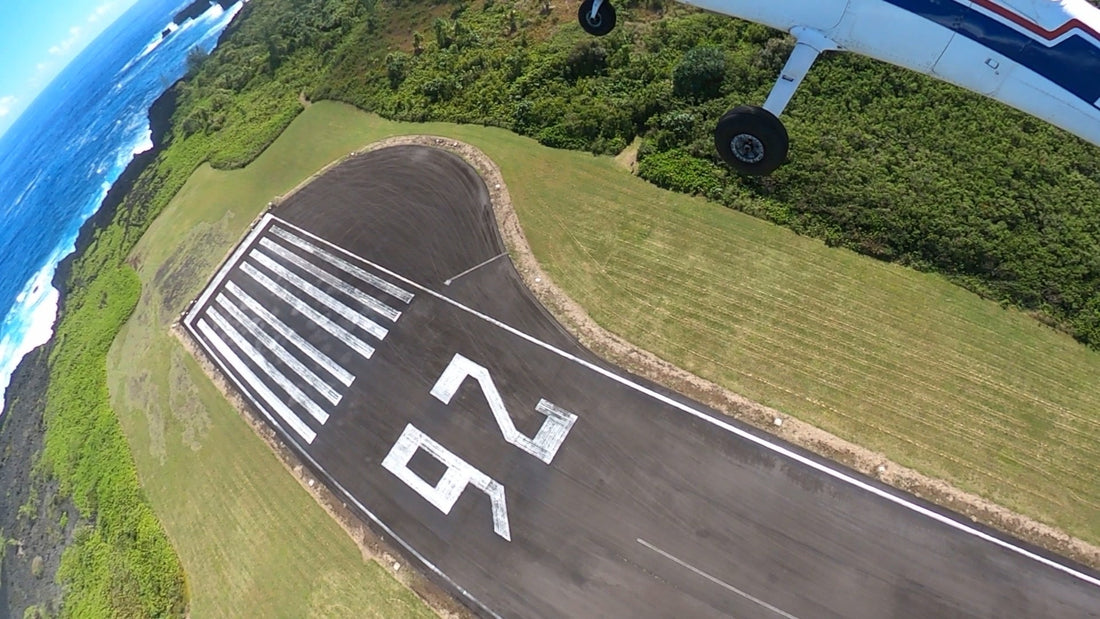
When To Go Around: 6 Scenarios Every Pilot Should Prepare For
Ken Dravis is a singer/songwriter and pilot who has written and performed many songs about flying and his love for aviation. Probably his most well-known song is called “Go Around.” You may have even seen a few YouTube videos of jets doing go-around maneuvers set to Ken’s song.
The chorus goes like this:
You can always go around
If it don’t look right comin’ down
Don’t wait until you’re sideways maybe slidin’ on the ground
You can always go around. But, when to go around?
It’s a funny, upbeat song, but it has an important message. Too many pilots, especially student pilots, think of the go-around maneuver as something to feel guilty over and the circuit in the pattern after a go-around is like being put in the penalty box. The go-around is a maneuver which is critical to safety of flight and can even save your life one day. It’s something that should be normalized in training and in everyday flying and practiced repeatedly.
What is a Go-Around & When to Go Around
Let's start with the basic principle of the go-around. As an aircraft enters the traffic pattern, it begins the process of getting configured to land on the runway. As the plane descends toward the runway on final approach, it may encounter various scenarios where a safe landing cannot be assured. As soon as the pilot realizes this, they must abort the landing and climb back to traffic pattern altitude and attempt the approach and landing again.
How Do You Perform a Go-Around?
The go-around procedure varies between various aircraft categories and class, but the basic premise is the same. The aircraft that is descending toward the runway and decides to abort the landing must immediately climb away from the ground and gain altitude.
The procedure includes:
1) Power: Appropriate power (usually full power) is the first action once the decision to go-around is made.
2) Pitch: Pitch up to a climb attitude. Monitor the airspeed and positive rate of climb.
3) Flaps: Begin intermittently retracting the flaps once a positive rate of climb is established. One mistake that can be very dangerous is retracting all of the flaps at once.
4) Gear: Retract the landing gear. On some aircraft, you will alternate the flaps and gear retraction.
Always consult your Pilot's Operating Handbook (POH) for your aircraft for the proper procedure so you are equipped with basic principles of when to go around under different circumstances.
The go-around is a maneuver tested during your private pilot checkride. The standards set for the private pilot checkride are found in the Airman Certification Standards, Area of Operation IV: Takeoffs, Landings, and Go-Arounds, Task N: Go-Around/Rejected Landing.
If a go-around is a regularly practiced and performed maneuver, when should a pilot do one?
Let’s looks at some of the different scenarios when a pilot should perform a go-around:
Unstabilized Approach
This is the most common reason for a go-around, and there are many factors that could lead to an unstabilized approach. One factor is executing the approach with too high energy or too low energy. Airspeed fluctuations, whether too fast or too slow, create undesired changes in altitude. Corrective inputs are added with pitch and power, and before you know it, the airplane is just all over the place! It’s very challenging to butter a landing after an unstabilized approach, and if the landing is forced, it can result in a hard landing, porpoise, ballooning, or losing control on the rollout.
Some other factors that can contribute to an unstabilized approach are fatigue or distractions. Maybe you have “get-there-itis” and under a schedule pressure, feeling like you don’t have the extra time to perform a go-around. Weather, hazardous conditions, wind, or a congested pattern can also add challenges to the approach making it more likely to be unstable.
Remember the secret to a good landing is beginning with a good, stabilized approach!
No Visual References
This scenario is particularly true for instrument pilots flying in instrument meteorological conditions (IMC). There are several criteria that must be met for a pilot to descend below Decision Altitude/Decision Height (DA/DH) or Minimum Descent Altitude (MDA) on an instrument approach. At least one of the visual references for the intended runway must be visible and identifiable. This may be difficult if the weather is at or below minimums for the approach. At that time, the pilot will discontinue the approach and execute a missed approach, similar to the go-around maneuver.
Even in visual conditions in great weather, pilots can miss visual references that lead to the decision to go around. A pilot may be approaching an unfamiliar area and airport traffic pattern and set themselves up for an unstable approach. If you typically fly at larger airports with bigger runways, flying to a smaller field, particularly if surrounded by terrain, can create visual illusions that could lead to a bad approach and the need to perform a go-around.
Traffic/Animals/Objects on the Runway
We all have seen news reports of major carriers having to go-around because another aircraft entered the runway. These mistakes are usually human error either by pilots getting distracted during taxiing, taxiing at unfamiliar airports, or incorrect instructions by Air Traffic Control.
Animals or even objects may wander onto the runway, creating the need to go-around. My favorite airport to fly to in Hawaii (Hana, Maui/PHHN), would often have a pack of wild boars on the runway. More than once I’ve had to go-around because they would be hanging out on the numbers of Runway 8.
Whether you’re flying a Cessna 172 or a Boeing 737, you should always be prepared and ready to go-around to avoid any runway incursions or collisions. They can happen when you least expect it.
ATC Instruction
The Air Traffic Control Tower may see a scenario unfolding where the safest option is to instruct a pilot to go-around. There are many examples when ATC may instruct you to go-around, such as. Some of the situations where you must know when to go around are:
- There’s been an accident, runway incident, or emergency.
- Required separation is lost between arrivals, so ATC will instruct a plane to go-around.
- An aircraft takes the runway for departure but delays their takeoff roll. If an aircraft is on final, it may be instructed to go-around.
- If there are animals, debris, or vehicles on the runway.
- The aircraft appears to be lined up with a taxiway or incorrect runway.
Weather Hazards
Low visibility and wind shear are weather hazards that can create the need to go-around. If the visibility is too low, as mentioned earlier, a go-around or missed approach should be executed. At that point, the decision may need to be made to divert to an alternate airport. Wind shear can create landing hazards for all sizes of aircraft. Sometimes the wind can be an extreme crosswind that cannot be handled safely due to aircraft limitations or pilot skill. The safest action is to execute a go-around, try the approach again, or divert to an alternate airport.
Aircraft Malfunctions
This scenario is not as common, but aircraft malfunctions can happen creating the need to go-around. The most common malfunction is a landing gear issue, whether it’s a mechanical malfunction or pilot negligence. Sometimes as a pilot approaches the landing, they are unaware that the landing gear isn’t down correctly, and if they’re lucky, another pilot or ATC can advise so the plane can go-around and troubleshoot.
Other aircraft malfunctions can include engine problems, flap issues, and instrument/avionics malfunctions can cause an unstabilized approach and the need to go-around.
The go-around maneuver should be normalized in training, but there’s little margin for error. This is why your CFI will make you practice them regularly. It’s not only important to be ready to execute the proper procedure, but also practice your decision-making skills so when you encounter one of these scenarios, you’ll make the decision to go-around promptly, precisely, and safely.
By Leslie Caubble, CFI/IGI
Northstar Aviation References brings you the Pre-Tabbed ASA FAR/AIM, DIY tabs for your FAR/AIM and other pilot resources so that you can more easily study the regulations that form the foundation of your flying career or hobby. Have any questions? Check out our FAQs page or contact us. Check out other blog posts here.
